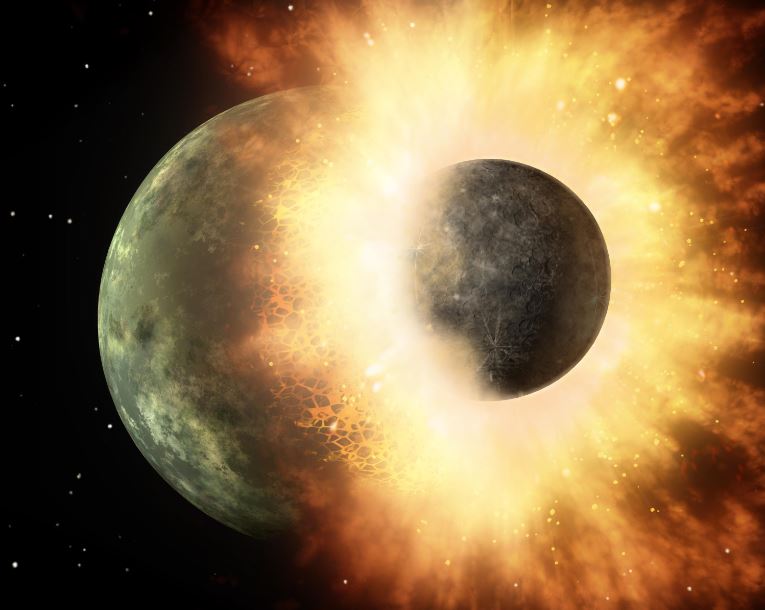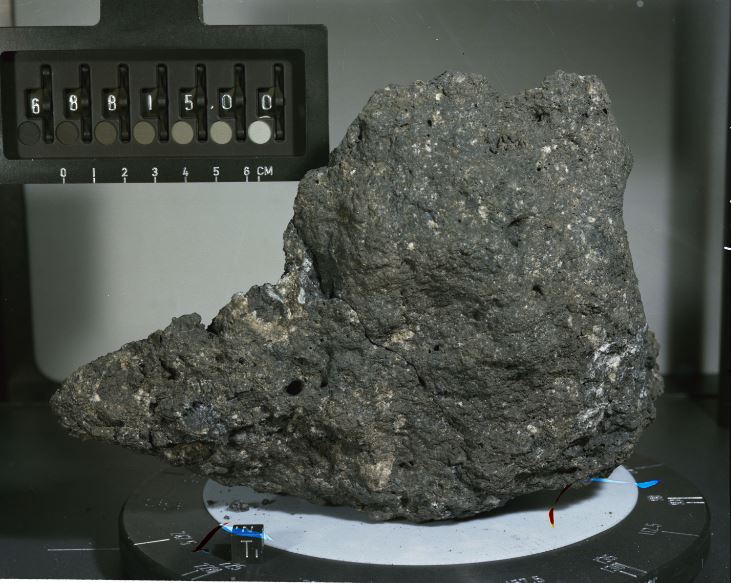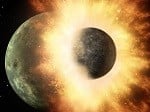A huge body about the size of Mars struck and merged with Earth, hurling a massive cloud of rock and debris into space, which eventually coalesced and formed the Moon. All this occurred within the first 150 million years after the formation of our solar system.
For the past thirty years, planetary scientists have accepted this explanation – with one major exception.
Although this explanation makes sense when you consider the size of the Moon and the physics of its orbit round the Earth, things start to fall apart slightly when you compare their isotopic compositions, i.e. the geological equivalent of a DNA ‘fingerprint’. The Earth and the Moon are just too much alike.
One would expect the Moon to carry the isotopic ‘fingerprint’ of the foreign body, which scientists have dubbed Theia. As Theia came from somewhere else in the solar system, it would likely have had a very different fingerprint to early Earth.

An artist’s depiction of the collision of two planetary bodies, which is believed to have created the moon within the first 150 million years after our solar system formed. (Image Credit: NASA/JPL-Caltech)
New study may have the answer
Scientists from the University of Maryland (UMD), who wrote about their findings in the academic journal Nature, have generated a new isotopic fingerprint of the Moon that may provide the missing piece of the puzzle.
By focusing on an isotope of Tungsten present in both the Earth and Moon, the team is the first to reconcile the accepted model of the formation of the Moon with the unexpectedly similar isotopic fingerprints of both bodies.
The results suggest the impact of the Mars-sized foreign body into early Earth was so violent that the debris cloud mixed thoroughly before settling down and forming the Moon.
Co-author, Richard Walker, a professor of geology at UMD, said:
“The problem is that Earth and the moon are very similar with respect to their isotopic fingerprints, suggesting that they are both ultimately formed from the same material that gathered early in the solar system’s history.”
“This is surprising, because the Mars-sized body that created the moon is expected to have been very different. So the conundrum is that Earth and the moon shouldn’t be as similar as they are.”

The scientists examined the tungsten isotopic composition of two moon rocks collected by the Apollo 16 mission, including sample 68815, seen here. (Image Credit: NASA/JSC)
Three theories
Over the years, several theories have emerged to explain the Earth’s and Moon’s similar fingerprints. Maybe the impact created a massive cloud of debris that mixed thoroughly with the Earth and then later coalesced to form the Moon.
It is also possible that Theia might have been, coincidentally, isotopically similar to young Earth.
A third possibility is that the Moon was formed from materials from Earth, rather than from Theia. However, for this to have occurred, it would have required an extremely unusual type of impact.
In their attempt to find an explanation, Prof. Walker and colleagues looked to another well-documented phenomenon in the early history of our solar system. According to evidence, both the Earth and Moon gathered additional material after the main collision, with the Earth collecting more of this debris and dust.
Tungsten-182 concentrations
There was a lot of Tungsten in this new material, but comparatively little of it was of a lighter isotope known as Tungsten-182. Taking these two observations together, you would expect the Earth to have less Tungsten-182 than the Moon.
Sure enough, Prof. Walker and team compared the rocks from the Earth and Moon and found that the Moon had a slightly higher proportion of Tungsten-182. The key, however, is how much.
Prof. Walker said:
“The small, but significant, difference in the Tungsten isotopic composition between Earth and the moon perfectly corresponds to the different amounts of material gathered by Earth and the moon post-impact.”
“This means that, right after the moon formed, it had exactly the same isotopic composition as Earth’s mantle.”
This finding supports the hypothesis that the mass of material created by the collision, which later formed the Moon, must have mixed together thoroughly before the Moon coalesced and cooled.
This would explain why overall the isotopic fingerprints are similar, but those of Tunsgten-182 are slightly different.
It also largely rules out the idea that Theia was of similar composition, or that the Moon formed from material from Earth before the impact.
In both cases, such a perfect correlation between Tungsten-182 and the amounts of material gathered by the Moon and Earth post-impact would probably not have been observed.
Prof. Walker said:
“This result brings us one step closer to understanding the close familial relationship between Earth and the moon. We still need to work out the details, but it’s clear that our early solar system was a very violent place.”
Citation: “Tungsten isotopic evidence for disproportional late accretion to the Earth and Moon,” Mathieu Touboul, Igor S. Puchtel & Richard J. Walker. Nature. Published 8 April, 2015. DOI: 10.1038/nature14355.

